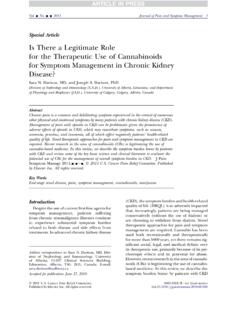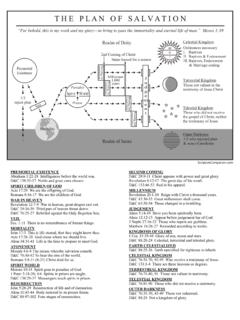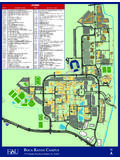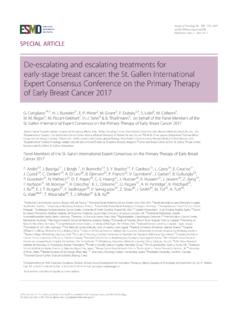Transcription of A Combined Preclinical Therapy of Cannabinoids and ...
1 2011;10:90-103. Published online January 10, Cancer Ther Sof a Torres, Mar Lorente, F tima Rodr guez-Forn s, et al. Temozolomide against GliomaA Combined Preclinical Therapy of Cannabinoids and Updated Version :Access the most recent version of this article at: MaterialSupplementary the most recent supplemental material at: Cited Articles #ref-list-1 This article cites 46 articles, 14 of which you can access for free at: E-mail alerts related to this article or up to receive free email-alertsSubscriptionsReprints Department atTo order reprints of this article or to subscribe to the journal, contact the at To request permission to re-use all or part of this article, contact the AACR Publications American Association for Cancer Research Copyright 2011 on February 13, from DevelopmentA Combined Preclinical Therapy of Cannabinoidsand Temozolomide against GliomaSof a Torres1, Mar Lorente1,F atima Rodr guez-Forn es1, Sonia Hern andez-Tiedra1,Mar a Salazar1,2, Elena Garc a-Taboada1, Juan Barcia3, Manuel Guzm an1,2, and Guillermo Velasco1,2 AbstractGlioblastoma multiforme (GBM) is highly resistant to current anticancer treatments, which makes it crucialto find new therapeutic strategies aimed at improving the poor prognosis of patients suffering from (THC)
2 , the major active ingredient of marijuana, and other cannabinoidreceptor agonists inhibit tumor growth in animal models of cancer, including glioma, an effect that relies, atleast in part, on the stimulation of autophagy-mediated apoptosis in tumor cells. Here, we show that thecombined administration of THC and temozolomide (TMZ; the benchmark agent for the management ofGBM) exerts a strong antitumoral action in glioma xenografts, an effect that is also observed in tumors that areresistant to TMZ treatment. Combined administration of THC and TMZ enhanced autophagy, whereaspharmacologic or genetic inhibition of this process prevented TMZ THC-induced cell death, supportingthat activation of autophagy plays a crucial role on the mechanism of action of this drug of submaximal doses of THC and cannabidiol (CBD; another plant-derived cannabinoid thatalso induces glioma cell death through a mechanism of action different from that of THC) remarkably reducesthe growth of glioma xenografts.
3 Moreover, treatment with TMZ and submaximal doses of THC and CBDproduced a strong antitumoral action in both TMZ-sensitive and TMZ-resistant tumors. Altogether, ourfindings support that the Combined administration of TMZ and Cannabinoids could be therapeuticallyexploited for the management of Cancer Ther; 10(1); 90 103. 2011 multiforme (GBM), or grade IV astrocy-toma, is the most frequent class of malignant primarybrain tumor and one of the most aggressive forms ofcancer. As a consequence, median survival after diagno-sis is usually just 12 to 15 months (1 3). This dramaticbehavior is mainly due to the high invasiveness andproliferation rate of GBM. In addition, GBM exhibits ahigh resistance to standard chemotherapy and radiother-apy. Current strategies for the treatment of GBM are onlypalliative and include surgical resection (which is fre-quently incomplete because of the proximity of the tumorto vital brain structures) and focal radiotherapy (1 3).
4 Alarge number of chemotherapeutic agents [ , alkylatingagents such as temozolomide (TMZ; SupplementaryFig. 1) and nitrosureas such as carmustine] have alsobeen tested, but they display limited efficacy (1, 2). It istherefore essential to develop new therapeutic strategiesfor the management of GBM. Nowadays, it is believedthat the development of new combinational therapies,together with an increase in the selectivity of the treat-ments based on a detailed molecular characterization ofthese tumors (4, 5), may contribute to enhance the survi-val of patients suffering from (THC; Supplementary Fig. 1),the main active component of the hemp plantCannabissativa(6), exerts a wide variety of biological effects bymimicking endogenous substances the endocannabi-noids that bind to and activate specific cannabinoidreceptors (7). So far, 2 G protein coupled, cannabinoid-specific receptors have been cloned and characterizedfrom mammalian tissues: CB1, abundantly expressed inthe brain and at many peripheral sites, and CB2, expressedin the immune system and also present in some neuronsubpopulations and glioma cells (7, 8).
5 One of the mostactive areas of research in the cannabinoid field is thestudy of the potential application of Cannabinoids in thetreatment of different pathologies (9, 10). Among theseAuthors' Affiliations:1 Department of Biochemistry and Molecular BiologyI, School of Biology, Complutense University,2 Centro de Investigaci onBiom edica en Red sobre Enfermedades Neurodegenerativas (CIBERNED),and3 Department of Neurosurgery, Hospital Cl nico San Carlos, Madrid,SpainNote:Supplementary material for this article is available at MolecularCancer Therapeutics Online ( ).S. Torres and M. Lorente contributed equally to the Author:Guillermo Velasco, Department of Biochemistryand Molecular Biology I, School of Biology, Complutense University, C/Jos e Antonio Novais s/n, 28040 Madrid, Spain. Phone: 34-913944668;Fax: 34-913944672; E-mail: 2011 American Association for Cancer Cancer Ther; 10(1) January 201190 American Association for Cancer Research Copyright 2011 on February 13, from applications, Cannabinoids are being investi-gated as antitumoral agents (11, 12).
6 Thus, cannabinoidadministration curbs the growth of several types of tumorxenografts in rats and mice (11, 12) including gliomas (13 16). On the basis of this Preclinical evidence, a pilot clinicaltrial has been recently conducted to investigate the anti-tumoral action of THC on recurrent gliomas (17). Themechanism of THC antitumoral action relies on the acti-vation of an endoplasmic reticulum stress-related signal-ing route that leads to the upregulation of thetranscriptional coactivator p8 and its target the pseudo-kinase tribbles homologue 3 (TRB3; refs. 13, 18). Thestimulation of this pathway promotes autophagy and isindispensable for the proapoptotic and antitumoral actionof THC (15, 19).Aside from THC,C. sativaproduces approximately 70other Cannabinoids , although, unlike THC, many of themexhibit little affinity for CB receptors (10, 20). Of interest, atleast one of these components, namely, cannabinol (CBD;Supplementary Fig.)
7 1), has been shown to reduce thegrowth of different types of tumor xenografts includinggliomas (20 25). Although the mechanism of CBD anti-tumoral action has not been completely clarified yet, it hasbeen proposed that CBD-induced apoptosis relies on anincreased production of reactive oxygen species (ROS; ), a mechanism that seems to operate also in glioma cells(23, 25). Of note, the Combined administration of THC andCBD is being therapeutically explored (10, 20, 26),although its effects on the proliferation and survival ofcancer cells have only been analyzedin vitro(26).The present work was therefore undertaken to studythe potential synergic antitumoral action of TMZ (thebenchmark agent for the management of GBM) and THCand CBD. Our results support that administration of TMZand these Cannabinoids could enhance the efficacy ofstandard TMZ-based antitumoral therapies for and MethodsReagentsTMZ was kindly provided by Schering-Plough.
8 THC,CBD, THC-botanical drug substance (THC-BDS; THCcontent w/w; CBD content w/w; other indi-vidual plant Cannabinoids < w/w), and CBD-bota-nical drug substance (CBD-BDS; CBD content w/w;THC content w/w; other individual plant cannabi-noids< w/w) were kindly provided by GW Pharma-ceuticals. THC, THC-BDS, and CBD-BDS were obtainedas a resin, solvated in ethanol at a concentration of 100mg/mL, and stored at 20oC. Finally, the requiredamounts of each component were dried, weighted, andsolvated in dimethyl sulfoxide. A Sativex-like (SAT-L)preparation was prepared by mixing THC-BDS andCBD-BDS in a 1:1 (w/w) proportion. The cannabinoidantagonists SR141716 (SR1) and SR144528 (SR2) werekindly donated by Sanofi-Aventis. Double-strandedRNA duplexes corresponding to human Atg1 (smart-pool) and control siRNA were synthesized by Dharma-con. The human glioma cell lines U87MG (U87), A172,SW1783, U373MG (U373), T98G (T98), SW1088, andLN405 were from ATCC and DSMZ or were kindlyprovided by Dr.
9 Javier Castresana (Universidad Pu blicade Navarra). Immunofluorescence of neural markers,gene expression profile with DNA arrays, and CGHanalyses were done after resuscitation in all the cell linesused in this study to corroborate that they had the featuresof human glioma cells. Primary cultures of brain tumorcells (designatedas HG19,HG2,and HG14)were obtainedfrom biopsies donated by the Tumor Bank Network,coordinated by the Spanish Cancer Research Centreand from the Hospital Cl nico culture and viabilityHuman glioma cell lines were cultured in DMEM containing 10% FBS. The preparation of adherent primarycultures of brain tumor cells was as follows: tumorsamples were homogenized, digested with type Ia col-lagenase (Sigma) for 1 hour, and incubated on ice for 10minutes. The supernatant was collected and, after cen-trifugation to discard the remaining death-floating cells,was resuspended in DMEM containing 15% FBS. Finally,cells were seeded at a density of 400,000 cells/cm2andkept in culture for 2 weeks in DMEM containing 15% FBSand 1% glutamine.
10 Cells were transferred to a serum-freemedium (human glioma cell lines) or a FBS medium(primary cultures of glioma cells) before doing the dif-ferent treatments. When indicated, cells were preincu-bated with SR1, SR2, ISP-1, 3-MA, or QVDOPH for 1 hourbefore treatment with the antitumoral agents. Cell viabi-lity was determined after 72 hours of drug treatment byusing the MTT test (Promega) according to man-ufacturer s instructions. Stock solutions of cannabinoidagonists and antagonists were prepared in dimethylsulfoxide. Control incubations contained the sameamount of dimethyl sulfoxide, and no significant effectwas observed in any of the parameters determinedthroughout this study at the final concentration used( , v/v).Cell transfectionsSeventy-five percent confluent U87 cells were trans-fected with control (siC) or human Atg1 (siAtg1) siRNAs,using the X-tremeGENE siRNA Transfection Reagent(Roche) according to manufacturer s hours after transfection, cells were trypsi-nized and seeded in complete medium at a density of5,000 cells/cm2.









